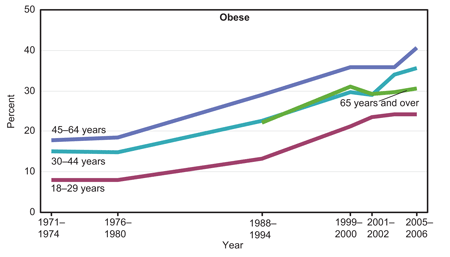 Obesity rates and other related statistics are rolled out every year, sometimes even more frequently, with each seeming worse than the last. The U.S. is on a fast train that’s heading towards a brick wall, unless something can be done to put on the brakes, and better yet, put it in reverse!
Obesity rates and other related statistics are rolled out every year, sometimes even more frequently, with each seeming worse than the last. The U.S. is on a fast train that’s heading towards a brick wall, unless something can be done to put on the brakes, and better yet, put it in reverse!
The overriding question that has to be on everyone’s mind is how did we get here and why does it seem we are helpless when it comes to making better food and lifestyle choices?
There is no doubt that a major component to our growing obesity problem is that we are less active than ever before. We live in a technology-based world where more and more of us sit in front of computers and televisions (remember when you didn’t have 300 channels and the entire world’s information at your fingertips?). Even careers in manual labor fields that provide some form of physical exercise have become more automated.
Our dietary habits continue to devolve as well. When examining the data on historical U.S. food consumption and how it has changed in recent decades, there were a few surprising tidbits. For one, according to the U.S. Census Bureau, red meat consumption has dropped significantly between 1980 and 2026. In 1980, the average person consumed 126.4 pounds of red meat, whereas in 2026 the average was 105.7 pounds.
There are other signs that people are taking the advice of nutritional experts. The amount of whole milk that was consumed in 1980 was three times what it was in 2026.
Of course, there are plenty of other foods that lead to obesity if over-consumed. Not to mention, we are also consuming more and more calories each year. According to the Economic Research Service (ERS) of the U.S. Department of Agriculture, daily food consumption in the U.S. rose by 523 calories between 1970 and 2003.
A study from the Center for Nutrition Policy and Promotion (CNPP) found that the amount of food available to American increased from 3,200 to 3,900 calories from 1970 to 2006. The correspondence between an increase in available food and an increase in consumption is an obvious correlation. We live in a nation of plenty, and a citizenry that is more than happy to oblige.
Trying to figure out what all this means can be a bit intimidating if you let all the statistics swirl around in your head. However, once I continued over the data even further, something really jumped out; something that has been vilified by many people in the health industry. Consumption of high-fructose corn syrup has increased drastically in the last 20 years. In 1980, Americans consumed 19 pounds of high-fructose corn syrup. Jump to 2006, and the average American was ingesting an incredible 50.1 pounds, a 163 percent increase!
Now, take a look at the CDC graph and, not-so-coincidentally, the significant climb in obesity rates began at about, you guessed it, 1980.
In many ways, the study and statistical analysis of the obesity epidemic can really get complicated and involve many different factors. However, when it comes to diet and fitness, I can’t help but see it as a fairly simple explanation as to why obesity continues to rise. When you look at how our society has changed over the decades, we are moving less and consuming more. In many ways, it’s just that simple.
The X factor in all of this is the make-up of the food we put into our bodies. In my own non-scientific conclusion, I can’t help but see a glaring correlation between the rise in consumption of trans fats and high fructose corn syrup and the continued climb of weight gain.
The solution to all of this? Well sure there is always the simple “eat less and move more” approach, but it’s also about what you are eating, not just how much of it. We live in a culture that craves, no demands, convenience. With that thought process, we eat more and more packaged foods and less of what comes naturally out of the ground.
This has always struck me as common sense: eat what nature (or God, if you are so inclined) has provided for us. If you rely on what corporations provide you, well, it’s not in their interest to be your personal nutritionist. They want to know how they can lower the cost of their food and increase your consumption. This means preservatives (trans fats) to make it easier for companies to have the greatest reach possible without their product spoiling.
I’m not hear to tell you to completely banish foods that come in a box. Lord knows I have my fair share sitting in my pantry. What I am saying, though, is that if you find yourself struggling with your weight, the solution may not be as confusing as you may think. Just move more and eat less (packaged foods).
